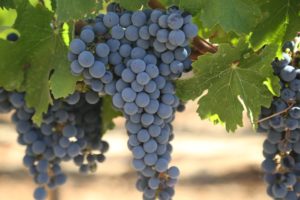
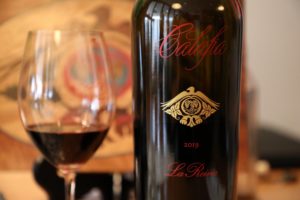
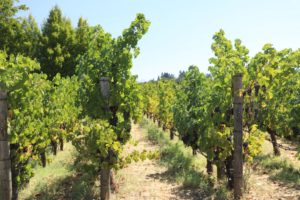 Calafia Cellars was founded in 1979 with the release of their first vintage and is owned by Randle & Mary Lee Johnson; Randle has been the winemaker since their inaugural vintage. During the early years of Calafia, Randle was making 7 different wines and around 2,000 cases. Later, and for a number of years he made just one wine, a Napa Valley Cabernet Sauvignon. Today he crafts several wines including a very small production red wine blend from their one-acre estate vineyard on Fulton Lane in St. Helena, a rare Verdelho (from Amador County) and also a rosé of Pinot Noir.
Calafia Cellars was founded in 1979 with the release of their first vintage and is owned by Randle & Mary Lee Johnson; Randle has been the winemaker since their inaugural vintage. During the early years of Calafia, Randle was making 7 different wines and around 2,000 cases. Later, and for a number of years he made just one wine, a Napa Valley Cabernet Sauvignon. Today he crafts several wines including a very small production red wine blend from their one-acre estate vineyard on Fulton Lane in St. Helena, a rare Verdelho (from Amador County) and also a rosé of Pinot Noir.
Randle was born and raised in the San Francisco Bay Area in California; after graduating from UC Davis with a M.S. in Viticulture he began his first wine related job at Sovereign Vineyard Management company (back when the founder of Chateau Souverain Lee Stewart had recently sold and both the brand and the winery were going through significant changes and transitions including ownership by Pillsbury for a few years (see our review on Burgess Cellars for much more detailed notes about Chateau Souverain). His first position was not with winemaking but rather in the vineyards – working with viticulturist Phil Baxter (Baxter Vineyards in Anderson Valley) and the father of Napa Valley winemaker Sam Baxter. And Randle was able to work and travel with noted winemaker André Tchelistcheff.
From 1972 until 1976 Randle worked with grapes growing on the floor of Napa Valley. In 1977 Randle moved into the ‘mountains’ and became the Vineyard Manager and Cellar Master for Bob Travers at Mayacamas Vineyards; this was his early introduction to the rugged nuances of working with Mt. Veeder grapes and his first time working with robust mountain tannins. And learning how to manage their grippy characteristics.
Randle was the first winemaker at Stags’ Leap Winery for several years and the founding winemaker at Hess Collection (now Hess Persson Estates) in 1983. When he started working at Hess Collection, he told us, he had, “tannins burned into my brain”. He and Jeff Baker, who was winemaker at what was Carmenet Vineyards, were the first California based winemakers to introduce pigéage for Bordeaux reds. Randle re-designed the Hess Collection production space with tannin management in mind. Ultimately he spent near 40 years winemaking at Hess Collection.
While at Hess Collection he had the privilege to work with not only Mt. Veeder vineyards but other mountain vineyards, including one of the highest vineyards in the world in northern Argentina, the impressive Bodega Colomé, a several hour drive on dirt roads from Salta, with vines remarkably growing up to 10,200 feet. This is Argentina’s oldest winery with some vines still in the ground that date from 1854. See our notes under Hess Persson Estates for photographs and more details about this remarkable property. Of the hundreds of places and spaces we have visited outside of Napa Valley with connections to wineries in Napa Valley through ownership, heritage or family ties, this property may well be the most memorable that we have yet visited. For many years until more recently, Randle worked two harvests – both in Napa Valley as well as in South America. Although he does not visit Bodega Colomé as much as he used to since they have a well-established winemaking team now.
During the first years of Calafia he sourced fruit from both the east and west facing (Napa & Sonoma) sides of the Mayacamas mountains. These sources were then used to create wines with an “east/west” blend of the varieties from the different exposures.
Calafia is the oldest operating “virtual” winery that we know of in Napa Valley continuously producing wine, yet never having owned a physical winery during its 45+ year history. We maintain a list of the oldest actively producing wineries in Napa Valley who began producing wine in the 1970s or prior. There are 68 Napa Valley wineries in this list who are still producing. For more information, reference it here.
Randle is quick to point out he may not be as idealistic as he was when he first started working in the wine industry in the early 1970s but his passion has been un-tempered by the years. He says, “there should never be a day in the wine industry that you do not learn at least a few new things.” Refreshing advice from someone who has been in the business as long as he has. And advice that has really resonated with us over the years.
It is no coincidence that the varieties Malbec and Petit Verdot are in Calafia’s two wines and are grown in their estate vineyard. Randle has worked with both varieties for a number of years and loves the different characteristics that each bring to the wine. He first worked with Malbec in 1991 on a fluke when Mt. Veeder grower at the time, Michel Perret offered Randle and Hess Collection 5 tons not under contract. Randle remembers after they made this wine, “it changed our world”. The next year he asked Perret for more Malbec but it was already all sold.
So he tried to purchase Malbec from other growers, but received almost the same response from every grower he called, “No, we have sold all our Malbec to Dick Arrowood this year”. Randle credits Arrowood, the founder of Chateau St. Jean and Arrowood Wineries – both in Sonoma County, with promoting and developing this variety in northern California.
So Randle soon convinced senior management to plant Malbec on Mt. Veeder. They planted 56 acres; this was the second largest planting of Malbec in Napa Valley. Pleased with the results, they noticed it always ripened fully and never expressed any vegetal characteristics. And their enthusiasm for the variety spread to the other side of the valley. During one of winegrower and founder of Stagecoach Vineyard’s tasting, Randle spoke highly about Malbec. Krupp listened; he planted Malbec at Stagecoach Vineyard, eventually passing Hess Collection as the largest grower of this variety in Napa Valley.
Select Wines
The Calafia wines feature a pronounced elegance; and part of this, is careful tannin management resulting in a gentle touch of texture in all their wines. And these bottlings showcase a ripeness but never an over ripeness. And always balance. And these are important distinctions to note.
Rosé
The 2023 Calafia “The Princess” Rosé Pinot Noir is a 100% varietal saignée produced blend from 64% Sonoma Coast, 21% Russian River, 11% Mendocino and 4% Sta. Rita Hills representing 10 different clones of the variety. This wine was fermented for two weeks in stainless steel and then bottled in early February 2024. It is the color of cooked salmon; the bouquet is highly aromatic with citrus aromas including kumquat and an orange zest accompanied by rose petals and white raspberries. As the wine breathes, it becomes less citrus influenced and opens to notes of pineapple guava, passion fruit and lychee. This is a highly enjoyable wine to smell. Minerally on the palate with a flinty character, it reveals flavors of grapefruit, pomelo, raspberry and strawberry with very subtle kiss of dill on the finish. This is not just a light and bright bottling; as Randle told us, “you want rose wines to have plenty of flavor”. And it also contributes plenty of weight, sporting a fleshy and creamy mouthfeel in union with a bright and lively acidity. Refreshing, mouth watering and balanced perfectly. In terms of pairing, we would love to see how it complements a spicy Thai Pad Thai.
La Reina
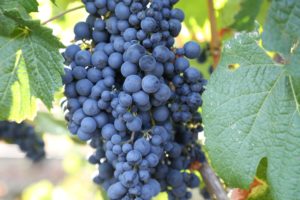
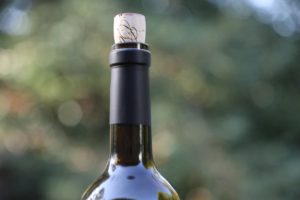 La Reina (meaning “the queen” in Spanish) St. Helena is from the one-acre Calafia estate vineyard on Fulton Lane in St. Helena. This vineyard is planted to the three varieties, all of which make up this wine: Cabernet Sauvignon, Malbec and Petit Verdot (all are co-fermented). The property is not far from the Napa River and as a result their soils contain a high amount of rounded river cobble (an important component for well-drained soils). The Califia property is Bale loam soils while the neighboring vineyard across Fulton Lane is planted in heavy clay soils. Calafia planted their estate vineyard in 2000 and through the 2005 vintage its grapes were blended into their Napa Valley Cabernet Sauvignon. After 6 years, the grapes were mature enough to warrant its own bottling and 2006 was the inaugural vintage of La Reina.
La Reina (meaning “the queen” in Spanish) St. Helena is from the one-acre Calafia estate vineyard on Fulton Lane in St. Helena. This vineyard is planted to the three varieties, all of which make up this wine: Cabernet Sauvignon, Malbec and Petit Verdot (all are co-fermented). The property is not far from the Napa River and as a result their soils contain a high amount of rounded river cobble (an important component for well-drained soils). The Califia property is Bale loam soils while the neighboring vineyard across Fulton Lane is planted in heavy clay soils. Calafia planted their estate vineyard in 2000 and through the 2005 vintage its grapes were blended into their Napa Valley Cabernet Sauvignon. After 6 years, the grapes were mature enough to warrant its own bottling and 2006 was the inaugural vintage of La Reina.
For several decades their property was previously owned by Egisto Dal Porto, an immigrant to the U.S. from Italy in 1902. The property used to be home to a walnut orchard, several of these original trees, including old figs, still bare fruit.
The 2020 Calafia, La Reina is a blend of 61% Cabernet Sauvignon, 20% Malbec and 19% Petit Verdot; these percentages vary depending on vintage and yields but roughly follow the percentage of the varieties planted in the vineyard. This wine was fermented in an open tank with punch downs occurring 3-4 times per day followed by a gentle pressing using a basket press. It is deep ruby in color. The bouquet is fruit forward with aromas of cherry, red plum, raspberry, licorice with an appealing layer of clove and nutmeg in the fold. Randle attributes the baking spice attributes to one new Darnajou barrel during the aging. A savory note is also present including of dried herbs. This Napa Valley red blend is approachable, friendly and enjoyable. It also exhibits restraint – distancing itself from more opulent and contemporary Napa Valley red blends. On the palate there are flavors of red cherry, dark currant, cranberry and raspberry with a light kiss of lingering tobacco leaf. The grainy and gravelly textured tannins persist beyond the fruit on the juicy, bright, savory and mouthwatering finish.
The 2019 Calafia, La Reina is 70% Cabernet Sauvignon, 15% Petit Verdot and 15% Malbec. It was aged in 100% French oak for 25 months of which 33% was new and 67% one-used. Only 105 cases were produced. This wine is dark ruby in color; upon smelling the bouquet we immediately noted that this is not a fruit-forward Napa Valley crafted wine from this variety. Rather the bouquet is more restrained and more interesting with notes of cherry cola, a hint of anise, clove and other dark baking spices. If offers flavors of blackberry and plum along with black currant and chocolate. Texturally this wine shows a light to moderate grip with fine-grained tannins which are felt more on the front of the palate rather than on the finish. This wine lingers slightly savory with a light woodsy note, a hint of pepper and a light dry character. This wine drinks very well in its youth, but also has the characteristics to go many more years with the proper aging.
The 2007 Calafia La Reina is an elegant wine right out of the bottle, through the palate to the finish. The bout offers initially offers sweet floral notes which as it opens further, reveal aromas of blackberry and black currant. The mouth feel is characterized by its roundness and smoothness with flavors showing more red than darker fruits. The wine is very well balanced for being so young with fine grained tannins anchoring a lingering finish. Randle believes in managing the tannins well – within the vineyard and his wines finish smooth and silky. The texture of this wine is no different in that regard.
Zinfandel
When making Zinfandel for Hess Collection, Randle worked with approximately 40 growers across California. From that portfolio, he identified a single vineyard to work with for the Calafia Zinfandel: Florence Vineyard is located in the Rockpile appellation in Sonoma County and previously was being used by Hess Collection for a vineyard designated bottling of Zinfandel. The budwood for this vineyard came from the vineyard next to St. Peter’s Church in Cloverdale; the original vines on this property were planted by Jack Florence, Jr. in 1994.
Rockpile was established in 2002; according to the Rockpile Grapegrowers Organization, the first grapevines were planted here in 1872 by Sonoma County Sheriff, Tennessee Carter Bishop, also the founder or Rockpile Ranch in 1867. Grapevines were later planted in 1884 by Swedish immigrant S.P. Hallengren. Only 160 acres of vines are currently planted within the AVA. Its elevation ranges from 800-2100 feet with the majority of the vines growing above 1,000 feet. As a result of the elevation and proximity to the coast, wind is a prominent factor. The AVA is bordered on its east by Lake Sonoma. We remember visiting properties before Warm Springs Dam was built in 1983, creating what is now Lake Sonoma. We visited old home sites and a couple of ranches prior to the dam’s construction, using a metal detector to look for old coins and other artifacts.
The 2021 Calafia Zinfandel, Rockpile Florence Vineyard is 91% Zinfandel and 9% Charbono. It was aged for 20 months months in once-filled French oak barrels. This wine is medium ruby in color. The bouquet is highly expressive focused on its fruit core with aromas of raspberry, licorice, boysenberries and blackberry jam. As the wine evolves it offers additional layers of dessert aromas including vanilla, caramel, chocolate brownie, cinnamon and cardamom. The bouquet is a sweet union of both fruit and baking spices; this is a ripe expression of this variety, but never crosses the line into the territory of over ripeness. Balanced, soft and easy drinking in its youth; on the palate, there are flavors of dark cherry, blackberry, raspberry, and strawberry. The texture showcases finely polished tannins seamlessly integrated into the fruit filled finish. Medium acidity. This is simply an enjoyable bottling that expresses the ‘zin-ness’ of the variety without its often showy over ripeness or opulence. Randle refers to this wine as having the ‘yum yum’ attribute; it is clearly a ‘crowd pleaser’.
Charbono
Charbono is most often associated with Calistoga in the northern part of Napa Valley. However, Randle wanted a disease free source of this variety; his search led him to the Graziano Vineyard in Mendocino County, owned by Eddie and Frankie Graziano. Eddie’s grandfather Vincent planted Charbono in the 1940s and then Eddie planted another block in 1974.
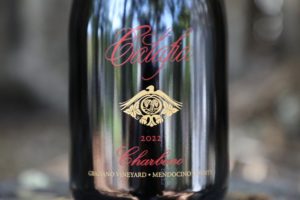 The 2022 Calafia Charbono Mendocino County (Calpella); this wine is 100% varietal and was aged for 20 months in 100% French oak barrels of which 25% were new. It is deep ruby in color, nearly opaque and immediately expressive showcasing the aromatic typicity of the variety. Smells floral including of violets, lavender, lilacs, and sage. A little moody too, and that is ok. The scents are brambly including of blackberry along with dark plum, crushed peppercorn and a gamey nuance. The palate offers flavors of plum (probably the most noticeable fruit flavor), boysenberry, blackberry, dark licorice and dark chocolate. And there are some gamey and dark spice characters at play here including of dark pepper. Intensely flavored. This is not your grandmother’s Charbono, although probably few grandmothers around here have ever tried wine from this variety. This variety can often have robust or edgy tannins; this bottling has none of those textural characteristics. Rather the tannins are ripe and rounded with a light drying attribute; they fit rather snugly, like the matching pieces of a puzzle, into the juicy and intensely flavored finish. This wine would go well with a well-marbled Wagyu steak.
The 2022 Calafia Charbono Mendocino County (Calpella); this wine is 100% varietal and was aged for 20 months in 100% French oak barrels of which 25% were new. It is deep ruby in color, nearly opaque and immediately expressive showcasing the aromatic typicity of the variety. Smells floral including of violets, lavender, lilacs, and sage. A little moody too, and that is ok. The scents are brambly including of blackberry along with dark plum, crushed peppercorn and a gamey nuance. The palate offers flavors of plum (probably the most noticeable fruit flavor), boysenberry, blackberry, dark licorice and dark chocolate. And there are some gamey and dark spice characters at play here including of dark pepper. Intensely flavored. This is not your grandmother’s Charbono, although probably few grandmothers around here have ever tried wine from this variety. This variety can often have robust or edgy tannins; this bottling has none of those textural characteristics. Rather the tannins are ripe and rounded with a light drying attribute; they fit rather snugly, like the matching pieces of a puzzle, into the juicy and intensely flavored finish. This wine would go well with a well-marbled Wagyu steak.
Cabernet Sauvignon
The same vineyard on Mt. Veeder has provided the majority of the Cabernet Sauvignon used in Calafia’s flagship wine for more than 30 years. The 2007 Calafia Napa Valley Cabernet Sauvignon is blended with Malbec grown in the Carneros region of Napa Valley as well as Petite Sirah. Production was down this year as only 250 cases were made. For reference, most years are around 600 cases. At the time of our tasting, this vintage had been recently released and still showed young but was surprisingly approachable, even in its youth. The palate offers darker fruits and some spices, a supple texture and a hint of toasty oak on the finish. Without the robust tannins a wine like this doesn’t need to pair with fatty foods – it will accompany a variety of dishes.
—
The name Calafia comes from a story every Californian should know. In 1979 Randle held a “name the winery” contest and a good friend who was a history teacher won the name by suggesting the word “Calafia”. While Columbus was on his first voyage exploring in the Caribbean, he hired guides to help him navigate around dangerous reefs. One of the guides told him of an island inhabited only by dark skinned women. Wanting to return to Portugal and running out of time to visit the actual island he had the guide give the story of this unique island to his scribe. The name of the queen of the island was never noted.
The story made its way back to Europe and the Spanish author Garcia Ordonez de Montalvo created the name “Calafia” as a fictional character in his book, The Adventures of Esplandián, written in 1503. When an expedition sent by explorer Hernán Cortés landed in what is now Baja California in the year 1513 they thought they had arrived on an island. Having read the book about Calafia and the “island of California” – Cortés called the land “Calafia’s Land.”
So perhaps the origins of the name of “California” essentially come from an author in Spain in the early 1500s who created a name of a fictional character in part based on a story that Columbus brought back with him to the old world.
Calafia’s distribution is selective within California and the wine is offered through their mailing list. For more information or to join Club Calafia, visit: www.calafiacellars.com






Leave a Reply